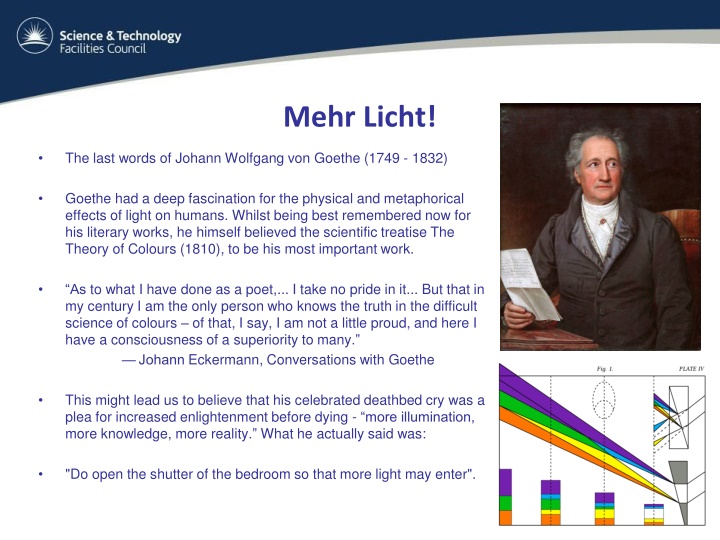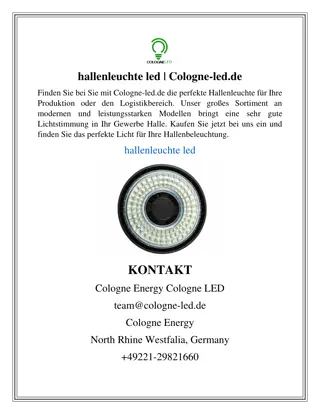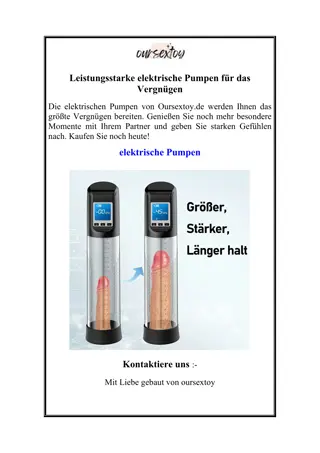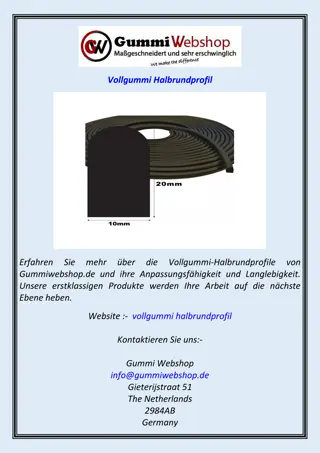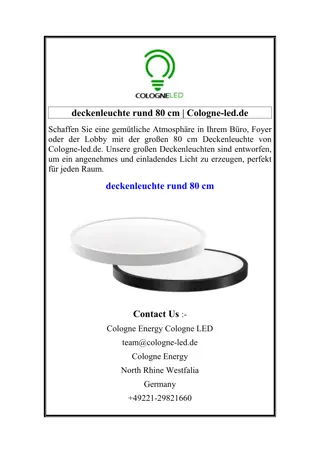Mehr Licht!
Johann Wolfgang von Goethe, known for his literary works, believed his scientific treatise on colors to be his most important work. His interest in the effects of light on humans is evident in his last words requesting more light. Explore how Goethe's legacy extends to modern research on light sources, axions, and synchrotron light advancements.
Download Presentation

Please find below an Image/Link to download the presentation.
The content on the website is provided AS IS for your information and personal use only. It may not be sold, licensed, or shared on other websites without obtaining consent from the author.If you encounter any issues during the download, it is possible that the publisher has removed the file from their server.
You are allowed to download the files provided on this website for personal or commercial use, subject to the condition that they are used lawfully. All files are the property of their respective owners.
The content on the website is provided AS IS for your information and personal use only. It may not be sold, licensed, or shared on other websites without obtaining consent from the author.
E N D
Presentation Transcript
Mehr Licht! The last words of Johann Wolfgang von Goethe (1749 - 1832) Goethe had a deep fascination for the physical and metaphorical effects of light on humans. Whilst being best remembered now for his literary works, he himself believed the scientific treatise The Theory of Colours (1810), to be his most important work. As to what I have done as a poet,... I take no pride in it... But that in my century I am the only person who knows the truth in the difficult science of colours of that, I say, I am not a little proud, and here I have a consciousness of a superiority to many. Johann Eckermann, Conversations with Goethe This might lead us to believe that his celebrated deathbed cry was a plea for increased enlightenment before dying - more illumination, more knowledge, more reality. What he actually said was: "Do open the shutter of the bedroom so that more light may enter".
HSP / Axion Limits from Accelerator Based Light Sources Peter Williams, Cockcroft Institute & Daresbury Laboratory, Axion-Like Particles Workshop, IPPP, 13thApril 2016
Light Shining Through the Wall Limits / discovery of axions / hidden photons can be set by LSW experiments Purely laboratory based confirmation of astrophysical limits should be seen as worthwhile as well as absolute limits Sensitivity proportional to e-m field strength = photon flux = stored energy in a cavity, so we need more light Either raw average power, enhancement through resonance or both! Really we want to create astrophysical conditions in the lab
Synchrotron Light Sources High Flux: high beam current in e storage ring (typically 500mA) determines flux = photons / (s x BW) High Brightness: small beam divergence = photons / (s x mrad2 x BW) High Brilliance: small beam emittance ( = invariant beam size + divergence) determines brilliance ( = luminosity in a collider) = photons / (s x mm2 x mrad2 x BW) Achieved by filling storage ring with undulators exploit constructive interference = narrow bandwidth at intermediate wavelength, additional bending enhances broadband intensity at short wavelength
Synchrotron Light Sources High Flux: high beam current in e storage ring (typically 500mA) determines flux = photons / (s x BW) High Brightness: small beam divergence = photons / (s x mrad2 x BW) High Brilliance: small beam emittance ( = invariant beam size + divergence) determines brilliance ( = luminosity in a collider) = photons / (s x mm2 x mrad2 x BW) Achieved by filling storage ring with undulators exploit constructive interference = narrow bandwidth at intermediate wavelength, additional bending enhances broadband intensity at short wavelength Full polarisation: either linear or circular Pulsed time structure: typically 10ps pulses CW High Stability: submicron variations over many days High availability: mature facilities, uptimes of >98% for months, top up injection = no beam fills a la LHC Many simultaneous user experiments typically 20 40 beamlines per synchrotron Broadband from VUV to hard X-ray (10 s eV to 10 s keV)
Axion Search at ESRF: 2010 ESRF ID06 delivered 1.2 x1012photons / s at 50.2 keV and 3.1 x 1010at 90.7 keV selected by monochometer Two magnets, each 3 T. 5mm think Ge detector, LN2 cooled, QE 99%@50keV, 84%@90keV Integration time of 2 hours for each wavelength (diminishing returns as limit 1/ t)
Axion Search at ESRF: 2010 ESRF ID06 delivered 1.2 x1012photons / s at 50.2 keV and 3.1 x 1010at 90.7 keV Two magnets, each 3 T. 5mm think Ge detector, LN2 cooled, QE 99%@50keV, 84%@90keV Integration time of 2 hours for each wavelength (diminishing returns as limit 1/ t) Not good enough! Increase the flux by orders of magnitude to improve (1 needed to exceed NOMAD limit from CERN- SPS neutrino beam, 3 to compete with laser LSW) Possible to use CAST at a synchrotron X-ray beamline?
HSP Search at Spring-8: 2013 SPring-8 BL19LXU delivered between 0.4 and 7 x 1013photons / s at 9 photon energies between 7 and 26 keV Very similar Ge detector to that at ESRF Integration time of ~8 hours at each photon energy
Ultimate, ultimate HSP Search: ILC Positron Source Spontaneous Undulator Baseline ILC design uses spontaneous undulator radiation generated by polarized electron beam to generate polarized positrons via pair production from 10-40 MeV gammas Courtesy Ian Bailey
Free Electron Lasers Next Generation SR Light Source Long undulator: narrowband radiation intensity growing exponentially until radiation field modulates energy of electron bunch then relativistic slippage microbunchingat radiation wavelength . Coherent radiation of the microbunches Low gain -> high gain -> saturation transitions on ALICE IR-FEL at Daresbury
Free Electron Lasers The Good Peak radiation powers increase by 106 Full coherence: free propagating radiation is therefore cavity like Full Polarisation: either linear or circular to 100% Short Pulses: typically 100fs, possibly 1 as!
Free Electron Lasers The Bad Only possible with fresh beam A beam in equilibrium with SR in a storage ring is too diffuse Linacs only = 1 pass = expensive and low average power Not mature facilities (FLASH, LCLS, FERMI, SACLA)
HSP/Axion Plans at SACLA: Proposed Would be first use of an X-ray FEL for HSP/Axion search Axions: Improvement by factor 40 from NOMAD is expected No mention of utilising the full coherence of the source is it relevant?
But, we dont want a low average power X-ray laser if were looking at meV, we want a high average power THz / IR laser A Blowtorch So far the killer app for FELs is molecular movies = time resolved X-ray diffraction so the demand for hard X-ray: 10 s 100 s keV ALSO the machine repetition rate kills the average brilliance compared to the 1010 passes in synchrotron! SOLUTION: High flux recoverable using SC linac - abolishing electrical resistance makes getting the energy into the beam much more efficient (60Hz LCLS vs macropulse EU-XFEL 4.5MHz for 600us at 10Hz). IDEAL SOLUTION: Full CW beam at MHz repetition rates = another 104 flux = a SC energy recovery linac ALICE@ Daresbury Operational for ~10 years - Unfortunately not CW, only 100us trains pulsed at 10 Hz. ERL-FEL designs are underway for ~100kW average power FELs at photon energies ~100eV .. But see later .
HSP/Axion Searches at Jlab ERL IR-FEL So not surprising that the only searches to date using an FEL have been at Jlab IR- FEL. It s an ERL and therefore capable of high average powers, up to 10 kW demonstrated (originally funded by US Navy for Star Wars) = a blowtorch
HSP/Axion Searches at Jlab ERL IR-FEL LIPSS (2009): 935nm but no cavity enhancement and 200W average power re-doing this would be competitive with ALPS-II table-top laser
HSP / Axion Search at a CW X-ray FEL Naively just extend the blue and yellow lines down by 6 orders of magnitude! This would require the equivalent of LCLS-2 using energy recovery operating with ~200mA average current a la storage ring Much more likely that a EUV machine would be built 100eV instead of 100keV
If someone builds a IR / UV / X-ray Blowtorch we will get high power coherent THz for free ! Provided a SC, CW linac in ERL configuration drives the FEL, it doesn t matter what the final resonant wavelength is because .. Coherent THz will be generated parasitically from the bunch compression process at about the same average power as the FEL! E.g TELBE@HZ-Dresden-Rossendorf Joerg: But, what about single photon THz detectors?
Single Photon THz Detection? There is activity developing single photon THz detectors charge sensitive infrared phototransistors In terms of the noise equivalent power (NEP), the detectors show experimental values of 7x10-20 W/Hz1/2 Additionally, intrinsic dynamic range expected to be 109, covering attowatt to nanowatt Wavelength range of 12-28 um, operate at 4.2K
Various ERLs Running / In Construction / Proposed ERL s are proposed for other applications, not just FELs e.g. high current electron source for EIC, electron cooler for ion beams, etc Running: Jlab FEL, ALICE, Budker Inst THz Recuperator Commisioning: cERL at KEK, Brookhaven ERL Prototyping: bERLinPro at HZ-Berlin Proposed: Cornell test ERL, LHeC, eRHIC More info
Conclusions Synchrotron, storage ring, third generation light sources struggle to break new ground and spectra peak at 10 s keV Free Electron Lasers should be capable of setting new lab bounds on HSPs / Axions In particular, FELs driven by SC energy recovery linacs would give a ~6 order of magnitude increase in average power High average power (100s kW) coherent THz for searching 10-100 meV range parasitic generation at FEL s of any fundamental wavelength Material science / chemistry / biochemistry demands that these facilities will continue to expand there are ~50 synchrotron light sources, developed in over 30 years. FELs will develop over the next 30 = many billions If we can use the light, we should .
